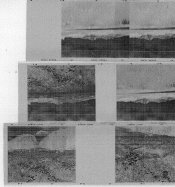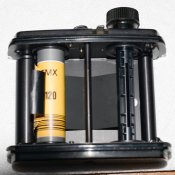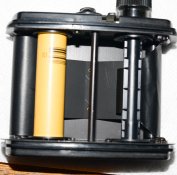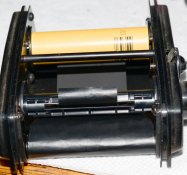Resize it to 1000 pixels on the longest side - jpeg format works well.
You can either copy and paste the result into the thread, or upload the resulting files to the thread, using the Upload link at the bottom of the posting box.
You can also store it elsewhere on the internet, and link to the URL.
Thanks, Matt!
If any of the lenses and backs are worn to the point of requiring replacement of important parts - not merely maintenance - or have suffered serious damage, than the kit is problematic.
This is my concern, since I don't know how to tell. The back works fine without film, as far as I can tell, and the 65mm seemed like it was fine. I'd mounted and removed it before without problems.
4. advance until the backing paper is over the tab in the slot then advance until the start arrows align.
View attachment 281614
View attachment 281615
View attachment 281616
View attachment 281617
Ok, I get what you mean. Thanks! I'm pretty sure that's what I did, but it's impossible to be 100% sure, now.
If this is your second roll of 120 film, which is how I read your post, it is way too early to talk about CLA'ing the entire set.
That's correct, this was my second roll of 120. Not my second roll ever, because I've run hundreds of rolls through various film cameras, some of which had funky loading procedures, but they were 35mm. And it's not my use of the camera that would make a CLA necessary. It was not CLA'd by its previous owner (at least, not recently), and sat on a shelf for a long time. The light seals were all deteriorated when I got it. I replaced those, but that's all I knew how to do, other than cleaning everything on the outside.
It is unlikely that all of your lenses and backs have identical problems.
Right. I'd be really surprised if they had the SAME problems, but I wouldn't be surprised if most or all of them had SOME problem(s).
it's common to have problems with the order of operations.
Yeah, user error is a definite possibility. I did end up with one unintended double-exposure, which could have been my fault.
It’s a precision mechanical system that’s maybe 50 years old. These machines need maintenance. This was the stuff dreams were made of when I was young and completely out of reach financially. Now they are cheap- and old. Many times I have spent more on maintenance and repair than I initially spent on the old gear. I’m paying for the privilege of using very high quality gear- compared to what this stuff cost new I am getting a great bargain IMHO. If you’re going to be counting it as a monetary investment it’s going to be tough I think. It’s an investment in your ability to make images.
All true. What I'm looking at is the possibility of spending a bunch of money on this gear versus having that money to spend on new gear that won't have any problems. I really like the process of shooting with the RB (when I can make it work). It forces me to slow down and think about it and switch off my habitual run-and-gun mode of shooting. But, I also like getting the image I thought I was getting.
The good news is, the RB67 was built to take heavy daily use (ten rolls a day was light duty!). The bad news is, many of the ones now on the used market did take that kind of use, for decades. It's not unreasonable to think a device with that much use might need some TLC -- if you bought a classic Mustang or Corvette (say, from 1968) with three hundred thousand miles on the odometer, you might expect to get it tuned up, belts and hoses and spark plugs/wires replaced, etc. before driving it even on weekend spins (while keeping your 2015 compact for the daily commute).
Sure, and when I bought a 68 Mustang many moons ago, I did those things. And then the A-frame broke, taking the unibody welds with it and sending the car to the junkyard. I'm hoping this isn't like that car.
So, thanks to Matt, I was finally able to upload the best image from the roll we've been discussing. Little Molas Lake in the San Juan mountains of Colorado.















